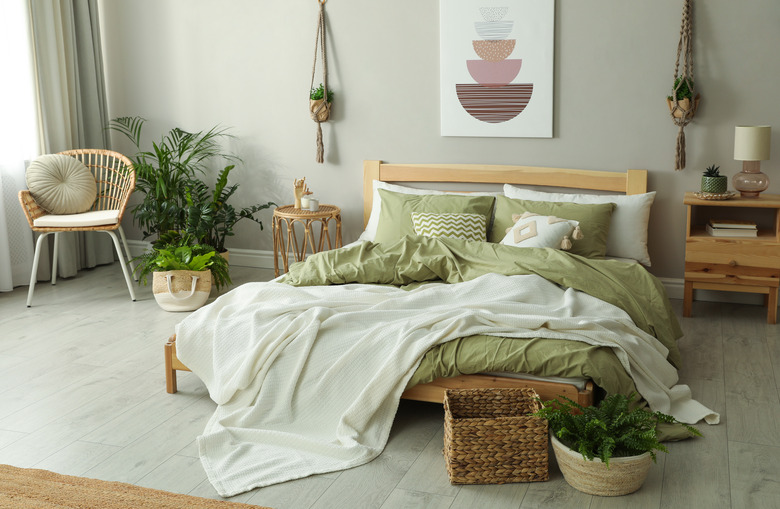Where Should You Place A Bed In A Primary Bedroom?
We may receive a commission on purchases made from links.
The best place for the bed in your home's primary bedroom might not be the same as it is in a friend's home across town. All primary bedrooms are not designed with the same layout, so the room's shape or even the window placement often dictates the potential locations for the bed. Ultimately, the best place for the bed is wherever it feels best to you.
Slightly Out of View
Slightly Out of View
A bed's position could play a role in how relaxed you are at bedtime, especially if others share the home with you. For instance, a bed placed directly opposite the door so that passersby have full view of you in bed may create an uneasiness as you rest, wondering who might walk in or walk by. Consider moving the bed farther along the wall opposite the door or even along another wall entirely so you see others entering the room before they see you in bed. While the symmetry of centering the bed along one wall looks nice, it's always the best option for peace of mind.
Centered on a Key Wall
Centered on a Key Wall
In many main bedrooms, one wall offers a larger, uninterrupted expanse than the others. If your room has a focal wall that stands out, such as one in a contrasting color to the remaining walls, this is another key area to allow the bed to take center stage. Set the bed with the headboard against the large, windowless wall or the focal wall; there's a good chance your room has one or the other, or these descriptions may even fit the same wall. This creates a balanced visual effect that's also great for highlighting a magnificent or oversize headboard, drawing the eyes toward the head of the bed.
If you aren't able to center the headboard along the chosen wall, as may be the case if the room is a bit small and the furniture is large or plentiful, position the bed in a way that still makes sense for the layout of the room. Allow ample room to get in and out of bed on either side with a clear pathway around the foot of the bed and to the door. It's important to be able to get out of or back into bed at night without tripping, bumping into things, or stubbing toes in the dark.
Go for the View
Go for the View
If the bedroom windows look out over some beautiful scenery, such as woods, mountains, or a body of water with no neighboring house windows nearby, position the bed for the maximum view in a way that still makes sense for the space. For instance, center the bed's headboard on the wall opposite some large windows with a great private view; this way, you're free to sit up in bed and take in the surroundings. If that's not an option, a wall adjacent to the windows may work, as you'll still be able to see outside and enjoy the view. Windows that face east may be the exception to this choice unless you enjoy waking up at sunrise or you install some seriously light-blocking blackout curtains.
The face-the-view option is best for second-floor or higher primary bedrooms and only when there are no neighbors across the yard that might see your bedroom window as their view.
Work With the Window Wall
Work With the Window Wall
Sometimes, the room's layout features two nicely spaced windows on the same wall with ample space for a bed between them. Use that as a focal wall, with the headboard between the windows. In some cases, one wall may have loads of windows, and it still may be the best location for positioning the bed's headboard. To make this positioning look more natural, use a tall headboard to turn the bed into the focal point. Hang artwork in the space to the side of the window and headboard to draw attention away from the window.
Make Zones in a Large Bedroom
Make Zones in a Large Bedroom
If the primary bedroom is large enough to house a fleet of king-size beds, you have options galore. Visualize the space in zones, such as a reading area, a home office area, and a sleeping area. Plot the ideal location for the bed based on your plans for each zone; choose whichever area seems the best for sleeping and put the bed there.
Floating the bed, which means positioning it more toward the middle of a room and not against a wall, works ideally in some large or long primary bedrooms. It also frees up space behind the bed and headboard for additional storage or another zone of the room, such as a home office area. A freestanding bookcase with the back side facing the headboard turns the area behind the bed into a personal library, or you can use furniture to transform that area into a wardrobe or closet space. Options abound, and there's no wrong way to organize if the space works well for you and you're comfortable within it.
